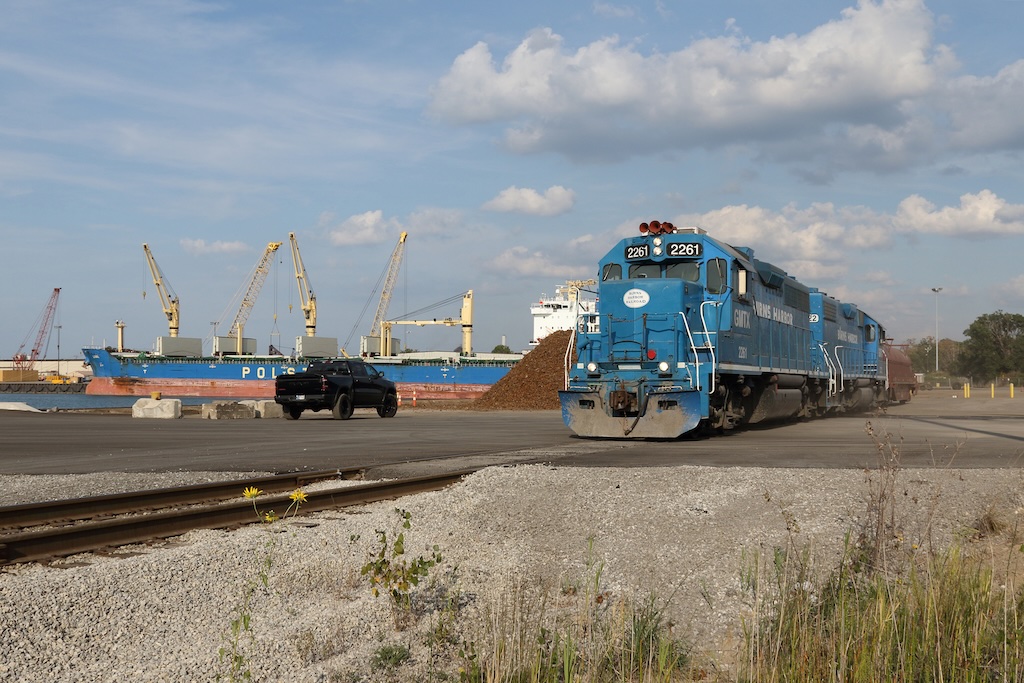
The Ports of Indiana-Burns Harbor has dedicated $25 million to infrastructure upgrades, including two new railyards and the port’s first all-new dock in two decades.
“Today marks a historic day for this region, our workers and this port,” Ports of Indiana CEO Jody Peacock said in a statement yesterday. “This is the first new dock Ports of Indiana has opened in 20 years and it signifies our commitment to support economic growth for our state. This new dock will provide critical global connections for Indiana companies and farmers as well as important jobs for local workers. But the best part is, this new dock is just the beginning of our major growth plans for this port, and there is much more development to come.”
The investment adds switching and storage capacity for 250 railcars at the Lake Michigan hub. Contract rail operator Regional Rail, LLC, operating as the Burns Harbor Railroad, handled more than 10,000 carloads in 2023 including steel products, scrap metals, chemicals and minerals, Peacock said in an email interview. It connects to the national rail network via Norfolk Southern.
Dedicated Sept. 5, the $6 million Berth 5 will serve ocean vessels with more than 500 feet of new dock designed to handle bulk shipments via self-unloading ocean vessels, lake carriers and river barges. It is also equipped for ship-to-transfers to barge, rail, truck, and nearby ground storage. Bulk commodities will likely include salt, fertilizer, limestone, taconite, foundry coke, grain products, and various aggregates.
Berth 5 funding included $2.4 million from a $9.85 million U.S. Maritime Administration (Marad) Fastlane Grant, Peacock said, and $3.6 million from Indiana Ports. The Fastlane grant also partially funded the new railyards and upgrades to berths 16 and 17 for vessel traffic on the port’s west side. Total investment for all projects was $25 million, 40% of which will be reimbursed by Marad.
Berth 5 is one component of $77 million in new investments currently under construction at the port that includes doubling capacity for truck traffic accessing the port; increasing rail storage by 1,200%; adding two additional docks and developing Indiana’s first container hub.
Indiana Ports in June received approval from U.S. Customs and Border Protection to start development of an international ocean container terminal at Burns Harbor, which is scheduled to open in 2026.
“Ports of Indiana is engaging with various partners to develop new container traffic at the port, including steamship lines, international ports, 3PLs and companies looking for alternatives to their existing supply chain,” Peacock said in the email. “We’ve completed trade missions to four European ports to discuss the new service, and entered a Memorandum of Understanding with the Port of Antwerp-Bruges [in Belgium], the 13th largest container port in the world, to jointly pursue economic development initiatives and new container shipments.”
The ports are also pursuing additional partnership agreements with various entities, Peacock says, that have significant interests in developing new container services in the greater Chicago market and throughout the Great Lakes.
“We are looking at the advantages for customers that want to utilize the only all-water container service between Europe and Chicago to determine if there are benefits for reducing the carbon footprint of current supply chains, and creating alternatives to using East Coast ports or the Chicago intermodal rail ramps,” Peacock says.
About one-third of the port’s shipments are carried on barges and two-thirds by ships. The state also operates port facilities at Jeffersonville and Mount Vernon.














As long as the same ships comply with US/Canadian ballast tank rules. It was a Russian freighter who dumped his ballast water from Europe into the Port of Chicago-Calumet and the caused the zebra mussel explosion.
The St Laurence Seaway was a wonderful thing for trade, but it brought up a lot of aqua pests that never could get past the Niagara Falls.
Since longshoremen are pressing to strike on both the east and west coasts of the US, I wonder how the Port of Burns Harbor falls in the union scheme.
Believe West Coast long shoreman already under a new contract. Wouldn’t be surprised if a lot of Southeast long shoreman see what their brothers are making to the west of them and asking themselves that they want a raise.